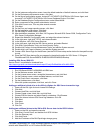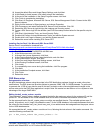
27
Principled Technologies, Inc.: Initial investment payback analysis: Dell PowerEdge R710
solution with VMware ESX vs. HP ProLiant DL385 solution
• The enterprise would typically select a 3-year support package with 7-day, 24-hour coverage, and 4-hour
response time for newer hardware, and would take over support internally after those agreements expire.
Therefore, for the Dell PowerEdge R710 solution, we included the costs for 3 Year ProSupport for IT and
Mission Critical 4HR 7x24 Onsite Pack in our cost estimates and divided those costs by 3 to show the
year-one cost.
• For the HP ProLiant DL385 solution, we estimated an annual in-house support cost of $400 per server
and $300 per storage array, plus costs to replace failed disks based on PT estimates of a 4 percent
annual disk replacement rate.
• Support agreements, the costs for which we include in the next category, would cover replacement of
failed disks for the Dell PowerEdge R710 solution.
We made the following assumptions in estimating the costs of software licenses and software support
agreements:
• The HP ProLiant DL385 solution used Windows Server 2003 R2 Enterprise Edition with per-server
licenses and SQL Server 2005 Standard Edition with per-server licenses, and the enterprise kept up-to-
date software assurance agreements for that software.
• The newer solution updated the operating system to Windows Server 2008 Enterprise Edition license by
upgrading some of the licenses used by the HP ProLiant DL385 solution.
• The newer solution updated the SQL Server software to SQL Server 2008 Standard Edition by upgrading
some of the licenses used by the HP ProLiant DL385 solution.
• The enterprise used their Software Assurance new version rights to upgrade the licenses they needed for
the newer solution. They saved the cost of the remaining software assurance agreements. These
agreements were due for renewal at the time of the solution acquisition.
• The enterprise already owned the necessary CALS; thus, they fell outside the scope of the solution.
• Costs include VMware vSphere 4 Advanced with a list price of $2,245 per processor and VMware
vSphere 4 Advanced SnS at $472 per year. The enterprise spreads the cost of VMware vSphere 4
Advanced license over three years.
We made the following assumptions in estimating facility costs, which include rack-based space costs and
Ethernet port costs:
• We estimated a fixed data center cost per rack, prorated by the percentage of the rack the solution used.
The older HP ProLiant DL385 solution requires 5u for each of the nine server-and-storage-array pairs, for
a total of 45u; by contrast, the single Dell R710 solution consumes only 5u.
• We estimated an annual per-enclosure cost for data center ports of $179 based on PT experience.
We made the following assumptions in estimating energy costs:
• We calculated energy costs for active and idle power consumption values (shown in Figure 7).
• The server and storage array have an average year-round power utilization that is the average of the
active and idle power from the benchmark runs.
• Average cost per kWh of power. Source: National commercial average for December 2008 from
http://www.eia.doe.gov/cneaf/electricity/epm/table5_6_a.html
. The December average was $0.995. We
rounded up to $0.10 to allow for rising prices.
• We estimated the energy cost of cooling the servers and storage arrays to be equal to the energy cost
required for running the solutions. The total energy cost was therefore twice the cost of running the
solution.
We used the following assumptions in estimating the management costs:
• Each server administrator managed 40 servers.
• We included an additional cost per storage array for storage array management. These costs were in
addition to the support costs under support, maintenance, and service contract costs for hardware.


















